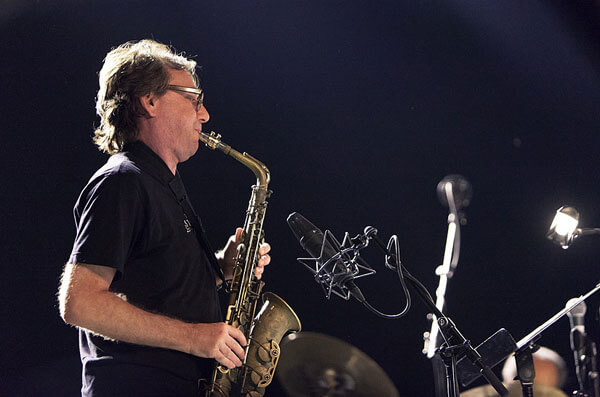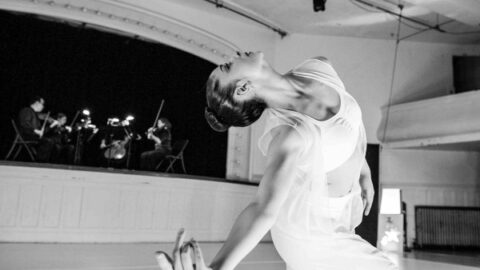“American music! What’s its stylistic range, and what’s its dance potential?” asked New York Times dance critic Alastair Macaulay in his coverage of a 2013 performance by the New York City Ballet. To Seattle-based choreographer Donald Byrd, Macaulay’s words presented a challenge. A year later, the Artistic Director of Seattle’s Spectrum Dance Theater emerged with his answer: Six new works of modern dance, each set to a string quartet by an American composer.
Byrd’s collection of pieces was presented as part of Spectrum’s “Rambunctious: A Festival of American Composers and Dance“, which spanned two weekends in May 2014. A collaboration with musicians from Seattle’s Simple Measures chamber music series, the ambitious festival traced the evolution of the American string quartet from the beginning of the 20th century to the present day, including the world premiere of a work for trumpet and string quartet by Boston-based composer Don Krishnaswami.

“My idea of music for Rambunctious was to create a parallel structure where dance and music coexist together,” remarks Byrd. “The eye and the ear find each other.” Short works by George Gershwin, Aaron Copland, and Charles Ives represented the early decades of the 20th century. Full string quartets by Vincent Persichetti and Charles Wuorinen illustrated mid-century development of the musical form, while John Zorn’s “Kol Nidre” and Krishnaswami’s new quintet showcased recent innovation.
The seven-work program presents quite the challenge for a string quartet, but violinists Michael Jinsoo Lim and Liza Zurlinden, violist Laura Renz, and cellist (and Simple Measures founder) Rajan Krishnaswami powered through the marathon of pieces with energetic, though conservative, performances. The four musicians are well-matched collaborators, maintaining a unified string sound and impressive balance throughout the program’s diverse selections.
Since Byrd took the helm in 2002, Spectrum Dance Theater has emerged as a platform for artistic exploration of the American social, political, and cultural landscape. Together with the company’s ten dancers, Byrd tackles the complex issues of contemporary America head-on. Earlier this year, his work The Minstrel Show Revisited examined present-day racial stereotypes through the lens of 19th century African-American minstrel shows.
Byrd’s bold, provocative approach to controversial themes played a big role in Rambunctious’ most powerful works. His strikingly simple “Kol Nidre” nudges the audience into an uncomfortable psychological space. Set to John Zorn’s short piece of the same name, the work features a trio of dancers. In the spotlight, two white-clad women curve, twirl, and stomp in a seeming parody of a seductive harem dance. Behind them, a dancer encased in a black sack lies in a formless lump.
As Zorn’s melancholy dirge swells, the sack begins to twitch slowly, convulsions increasing until the figure appears to be writing in agony. The female dancers whirl on, oblivious. It’s a disturbing sight, yet fascinating, evoking more questions than answers. Are the women guarding the body in the sack, or mourning it? Who is the mysterious body, and who does it represent?

Persichetti’s String Quartet No. 2 and Wuorinen’s String Quartet No. 2 stood out as the festival’s two large-scale, multi-movement works. Byrd approached these two works very differently. Sprawling and evocative, his “I from myself am banish’d”, closely follows Persichetti’s writing, the dancers’ fluid motions fusing with the music as it flits from the folk-like snatches of the first movement to the quiet despair of the third.
In contrast, Byrd’s “Septet” trends towards the abstract and angular. One of most demanding works on the program, “Septet” is intense both physically and emotionally, demanding much athleticism from the dancers and touching on difficult themes of segregation and domination. Echoing Wuorinen’s score, Byrd’s choreography presents a collage of movements and poses. Full of acrobatic lifts and stylized sparring, the work simultaneously suggests collaboration and aggression. It’s often difficult to tell if the male-female pairings are dependent on one another or trying to dominate each other.
Performed sans dancers, Don Krishnaswami’s Quintet for Trumpet and Strings tempers the string quartet sound with the strident voice of the trumpet. The work draws heavily upon Shostakovich’s string quartet legacy, building tension with forlorn harmonies, scampering pizzicato, and meandering melodies passed between the strings. Trumpeter Brian Chin’s expressive playing showcased the versatility of his instrument as he juggled melancholy serenades, brassy military fanfares, and everything in between. Despite the work’s dolorous mood, Krishnaswami’s writing possesses a lightness and buoyancy that lifts the piece out of a truly Shostakovichian despair.
The festival’s intimate staging placed the audience on a tiered set of risers that jutted right up against the square stage marked off on the floor for the dancers, with the musicians sitting nearby. Experiencing the performances at such a close proximity lent a very different feel than if they were viewed from across a large auditorium. Details popped out, each curl of the toe and flick of the wrist melding with the music to add meaning and color.
Byrd’s bold approach to controversial topics extends to his presentation of dance, which thins the boundaries between audience and performers. When works like these unfold mere feet away, they take on an extra element of rawness and intensity. Though Rambunctious is the final event in Spectrum’s 2013-14 performance season, I look forward to discovering what surprises Byrd has up his sleeve for the upcoming season.
























